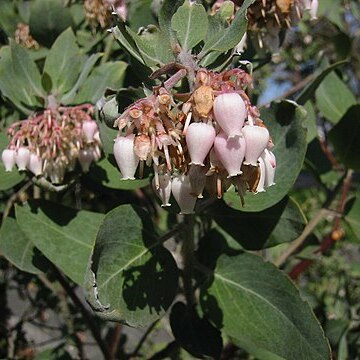Shrubs or trees, either burled and resprouting after fire or not burled and killed by fire; bark usually promptly exfoliating, reddish, (thin), or, sometimes, persistent, gray, rough, shredded (A. morroensis, A. nissenana, A. nummularia, A. osoensis, A. pajaroensis, A. rudis, A. tomentosa). Stems prostrate to erect, glabrous or hairy, sometimes glandular. Leaves (usually spreading, sometimes erect, sometimes overlapping when petiole is short), usually isofacial, sometimes bifacial in stomatal distribution (stomata present only on abaxial surface) and usually in color or pubescence (A. andersonii, A. crustacea, A. edmundsii, A. insularis, A. morroensis, A. nummularia, A. pajaroensis, A. pumila, A. sensitiva, A. tomentosa, A. uva-ursi); petiole absent or present; blade ovate to elliptic, coriaceous, margins entire (serrulate in A. pacifica, rarely so in young plants or resprouts, sometimes ciliate), usually plane, rarely revolute, surfaces (smooth to papillate or scabrous), hairy or glabrous. Inflorescences racemes or panicles (panicle branches racemelike), 5-20(-50)-flowered, (partially developing with new stem growth and dormant (immature inflorescences) for 6-9 months, usually pendent, can be erect when immature, pendent in flower; bracts persistent, (deciduous after flowering in A. pringlei), tan or light brown, scalelike, sometimes keeled, deltate or ovate, (tips often marcescent), or hue as in leaves, leaflike, narrowly lanceolate and flat, buds usually clustered, bracts imbricate, sometimes buds spread apart on axis, bracts not imbricate); bracteoles absent. Flowers bisexual; sepals persistent, 5 (4 in A. nummularia, A. sensitiva), distinct, ovate to deltate; petals 5 (4 in A. nummularia, A. sensitiva), connate nearly their entire lengths, white to pink, corolla conic to urceolate; stamens (8-)10, included; filaments dilated, (usually hairy at base); anthers (dark red), with 2 (recurved), dorsal awns, dehiscent by terminal pores; ovary 2-10-locular; stigma capitate. Drupes red, reddish brown, or brown, globose or depressed-globose, (exocarp coriaceous, rarely thin), smooth, (mesocarp usually dry, mealy, rarely absent, endocarp multiple-seeded); pyrenes 1-10, connate or not. Seeds 1-10, distinct or connate along radial faces of stony endocarp into 2s or 3s, sometimes connate into single sphere, (triangular-ovoid). x = 13.
More
Shrubs or small trees with diffuse to prostrate or erect stems. Leaves per-sistent or rarely deciduous, usually coriaceous, rarely membranous, often revolute, entire, undulate or toothed, pinnately veined, petiolate or sessile. Inflorescence of few to numerous flowers borne in terminal, solitary or clustered, racemelike panicles; pedicels slender, bibracteolate at or near the base, each subtended by a persistent or deciduous bract. Flowers with the calyx persistent with (4)5 nearly distinct lobes much longer than the calyx tube, spreading or reflexed at maturity; corolla urceolate, cylindric, ovoid, globular to somewhat campanulate, (4)5-lobed and the lobes often recurved or spreading; stamens (8)10, included, the filaments dilated and usually basally pubescent, the anthers introrse, each anther sac with a recurved dorsal hornlike spur, the thecae opening by introrse terminal pores; stigma minute or slightly capitately dilated, the style slender to columnar, ovary superior on a hypogynous disc, (2-)4-5(-10) celled. Drupe globose, usually fleshy but rarely dry, the pericarp smooth to papillose or warty; nutlets 4-10, seedlike, each with a solitary seed, the nutlets irregularly separable or united into a solid stone.
Fls 5-merous; cal saucer-shaped, the sep imbricate, distinct to the base; cor ovoid, the rounded lobes spreading or recurved; stamens 10; filaments pubescent, much-dilated below, much shorter than the cor; anthers subglobose, opening by 2 terminal pores and bearing 2 deflexed terminal awns; ovary 5-locular, conic-ovoid, subtended by a 10-lobed disk; style columnar; stigma capitate; ovules 1 per locule; fr a fleshy or mealy drupe with 5 bony nutlets; freely branched shrubs (ours low and creeping) with persistent, alternate lvs and white to pink fls in short, few-fld, terminal racemes. 45, mainly w. N. Amer.

